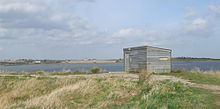| Site of Special Scientific Interest | |
 | |
| Location | Kent |
|---|---|
| Grid reference | TR 001 665 |
| Interest | Biological |
| Area | 6,509.4 hectares (16,085 acres) |
| Notification | 1990 |
| Location map | Magic Map |
| Designations | |
|---|---|
| Ramsar Wetland | |
| Official name | The Swale |
| Designated | 17 July 1985 |
| Reference no. | 299 |
The Swale is a tidal channel of the Thames estuary that separates the Isle of Sheppey from the rest of Kent. On its banks is a 6,509.4-hectare (16,085-acre) biological Site of Special Scientific Interest which stretches from Sittingbourne to Whitstable in Kent. It is also a Ramsar internationally important wetland site and a Special Protection Area under the European Union Directive on the Conservation of Wild Birds. Parts of it are a Nature Conservation Review site, Grade I, National Nature Reserves, a Kent Wildlife Trust nature reserve and a Local Nature Reserve.
History

The name "Swale" is Old English in origin, and is believed to mean "swirling, rushing river", or "rushing water".
Peri-glacial period
At these times the Swale was a gully from what had been a sea channel in very warm periods. Namely before the Strait of Dover had swept away so much swampy land, accentuated by sea levels being lower, even to beyond the end of the ice age, i.e. in the mid seventh millennium BC, the coasts of Essex and Kent stretched much further into the North Sea. Sheppey formed part of mainland Britain. The Swale was a valley opening eastwards. As sea-levels rose again, water occupied its whole length. It and the very mouth of the Medway divide the Isle of Sheppey from the mainland.
Roman Warm Period
When the Romans arrived in Britain, the Swale was much wider, with one part of the Isle of Sheppey — now called the Isle of Harty or Harty — a separate island.
Former ferries
Two c. 1600 to 1900 public ferries crossed the Swale. One operated between Oare and Harty, and the other between Murston (near Sittingbourne) and Elmley (another former hamlet and essentially attached islet). Harty is no longer separate but the marshlands gradually encroaching delineate it.
Dredging and channel traffic
The channel needs constant dredging for busy recreational and light vessel use.
Bridges
The Swale is crossed at its western end by two bridges: the Kingsferry Bridge and the later Sheppey Crossing.
Nature


The Swale forms both a National Nature Reserve and a Special Protection Area: the eel grass, Ray's knotgrass, white seakale, glassworts and golden samphire support rare and uncommon migrant butterflies and moths, including the Essex emerald, the ground lackey, the clouded yellow butterfly and rare hawk-moths. Since 1968, it has also been a Site of Special Scientific Interest.
Birds
The Swale provides habitats for the following birds:
- Pied avocet at least 17 percent of Great Britain's breeding population
- Marsh harrier at least 15 percent of Great Britain's breeding population
- Mediterranean gull
- Bar-tailed godwit
- Eurasian golden plover
- Hen harrier
- Ringed plover
- Black-tailed godwit
- Grey plover
- knot
- pintail
- Common redshank
- Northern shoveler
See also
- Swale (local government district)
References
- ^ "Designated Sites View: The Swale". Sites of Special Scientific Interest. Natural England. Retrieved 28 February 2018.
- "The Swale". Ramsar Sites Information Service. Retrieved 25 April 2018.
- "Map of The Swale". Sites of Special Scientific Interest. Natural England. Retrieved 28 February 2018.
- "Designated Sites View: The Swale". Ramsar Site. Natural England. Retrieved 22 January 2018.
- "Designated Sites View: The Swale". Special Protection Area. Natural England. Retrieved 22 January 2018.
- Ratcliffe, Derek, ed. (1977). A Nature Conservation Review. Vol. 2. Cambridge, UK: Cambridge University Press. p. 4. ISBN 0521-21403-3.
- "Kent's National Nature Reserves". Natural England. 2 August 2014. Archived from the original on 24 January 2018. Retrieved 23 January 2018.
- "Designated Sites View: The Swale". National Nature Reserves. Natural England. Retrieved 22 January 2018.
- "Designated Sites View: Elmley". National Nature Reserves. Natural England. Retrieved 23 January 2018.
- "Oare Marshes". Kent Wildlife Trust. Archived from the original on 23 January 2018. Retrieved 22 January 2018.
- "Designated Sites View: South Bank of the Swale". Local Nature Reserves. Natural England. Retrieved 22 January 2018.
- Ekwall, Eilert (1960), The Concise Oxford Dictionary of English Place-Names (4th ed.), Oxford: OUP, p. 455, ISBN 978-0-19-869103-7. Mills, A. D. (1998), A Dictionary of English Place-Names (2nd ed.), Oxford: OUP, p. 335. While Ekwall takes the origin of this name to be identical with that of the Yorkshire river, Mills says it is "probably identical".
- "SSSI The Swale" (PDF). www.sssi.naturalengland.org.uk. 1968. Retrieved 12 November 2013.
External links
51°21′43″N 0°52′23″E / 51.362°N 0.873°E / 51.362; 0.873
Categories: